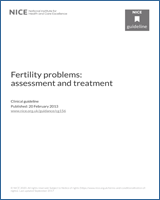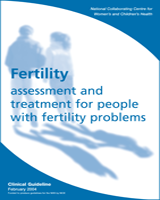Oncologists should be aware of conditions for which treatment is available and facilities for cryopreservation of gametes and/or embryos. A working party of the Royal College of Physicians and the Royal College of Radiologists1104 has recommended procedures to be followed before commencing chemotherapy or radiotherapy likely to affect fertility and the management of post-treatment infertility. A strategy for developing policy and practice in fertility preservation for survivors of cancer has recently been proposed by the British Fertility Society.1105 [Evidence level 4]
16.1. Semen cryostorage
Semen cryopreservation should be considered in conditions that impair fertility or need treatment likely to impair fertility, such as malignancies of the genital tract (for example, testicular cancer and prostate cancer) or systemic malignancies (for example, non-Hodgkin’s or Hodgkin’s lymphoma, and leukaemia). Survival rates in men with these conditions (who are often young) are promising and likely to improve in the future. For those about to receive chemotherapy or radiotherapy and those about to undergo a surgical procedure, loss or impairment of fertility is an important issue and cryopreservation of semen in such people has become a realistic option to preserve fertility, regardless of diagnosis and treatment.1105
Semen quality is adversely affected by the presence of cancer1106 and current techniques in cryopreservation of human semen substantially decrease sperm quality. The particular diagnosis of malignancy (for example, Hodgkin’s disease) is not an adequate predictor of the effect of cryopreservation on human semen.1107,1108 For men, elective sperm cryopreservation and banking at cancer diagnosis before the initiation of specific medical treatment and regardless of semen quality should be encouraged1109–1112 and offered1105 as an essential part of any comprehensive cancer care programme.1113,1114 Some people may later decide that the specimens are not needed.1112 Successful outcomes with IUI and IVF following successful treatment for malignancy have been reported in one retrospective review.1115 Cryopreserved semen from cancer patients before chemotherapy, although generally of poor quality, are sufficient for success with IVF or ICSI, irrespective of the duration of storage.1110,1115–1118 [Evidence level 3] An abstinence period of 24 to 48 hours can be recommended for sperm banking in cancer patients,1119 although in practice any samples available in the short period before cancer treatment begins are acceptable.
The possibilities for successful reproductive outcomes by means of sperm cryopreservation are encouraging for cancer patients whose complete loss of fertility could otherwise occur. As recommended by the report of a Working Party of the Joint Council for Clinical Oncology, there should be facilities and opportunities to offer men with disease undergoing treatment likely to impair their fertility the possibility of sperm cryopreservation before undergoing treatment. Oncologists should be aware, before commencing chemotherapy or radiotherapy, of the procedures likely to affect fertility and of the management of post-treatment infertility.1104 [Evidence level 4]
The particular issues facing adolescent boys who may also be capable of producing mature sperm and therefore benefiting from semen storage should be known to those treating their cancer and specialist advice and counselling should be available. A strategy for fertility services for survivors of childhood cancer has recently been developed, which highlights the concerns relating to consent to treatment and the need to consider the extent to which children are able and/or wish to participate in decision making.1120 [Evidence level 3–4]
16.2. Cryostorage of embryos, oocytes and ovarian tissue
Cryopreservation of embryos formed before anticancer treatment is undertaken is possible. A retrospective record review (n = 69) found that chemotherapy diminished the response to ovulation induction in assisted reproductive technologies. IVF with cryopreservation of embryos allows embryo banking before chemotherapy for women newly diagnosed with cancer. Delivery rates after the women had undergone chemotherapy tended to be lower among the systemic treatment group than it was for the local cancer treatment group (13% versus 40%).1150 [Evidence level 3]
Another possible treatment, available after anticancer treatment has been concluded, is IVF using donated oocytes (see Section 15.3).
Anticancer treatment can cause ovarian failure; however, cryopreservation of oocytes has had very limited success.1105,1121,1151 [Evidence level 3–4] Live births following ICSI for fertilisation of in vitro cryopreserved oocytes has been reported in women with1121 and without cancer.1122,1123 [Evidence level 3]
Cryopreservation of ovarian cortex before cancer treatment may be a valuable fertility conservation option1124 but its clinical practicality followed by ovarian transplantation needs further development and evaluation, as there has been no pregnancy in humans with this technique.1105,1121,1125 [Evidence level 3–4]
The handling and storage of tissues containing immature gametes (that is, ovarian cortex and immature testicular tissue) is outside the remit of the HFEA and is regulated by the Department of Health.218
Counselling
Counselling from someone who is independent of the treatment unit and information giving are an integral part of the management which will require a multidisciplinary input.1105 Local protocols between all health professionals involved are essential. However, many technical, legal and ethical considerations remain. For example, where cryopreservation is offered to young people who are preparing for medical treatment that is likely to make them infertile, secure long-term storage facilities may be needed.
RECOMMENDATIONS
Before commencing chemotherapy or radiotherapy likely to affect fertility, or management of post-treatment fertility problems, the procedures recommended by the Royal College of Physicians and the Royal College of Radiologists should be followed.
[D]
Men and adolescent boys preparing for medical treatment that is likely to make them infertile should be offered semen cryostorage because the effectiveness of this procedure has been established.
[B]
Local protocols should exist to ensure that health professionals are aware of the value of semen cryostorage in these circumstances, so that they deal with the situation sensitively and effectively.
[C]
Women preparing for medical treatment that is likely to make them infertile should be offered oocyte or embryo cryostorage as appropriate if they are well enough to undergo ovarian stimulation and egg collection, provided that this will not worsen their condition and that sufficient time is available.
[C]
Women preparing for medical treatment that is likely to make them infertile should be informed that oocyte cryostorage has very limited success, and that cryopreservation of ovarian tissue is still in an early stage of development.
[D]
People preparing for medical treatment that is likely to make them infertile should be offered counselling from someone who is independent of the treatment unit to help them cope with the stress and the potential physical and psychological implications for themselves, their partners and any potential children resulting from cryostorage of gametes and/or embryos.
[GPP]
Where cryostorage of gametes and/or embryos is to be undertaken because of medical treatment that is likely to make people infertile, this should occur before such treatment begins.
[GPP]


